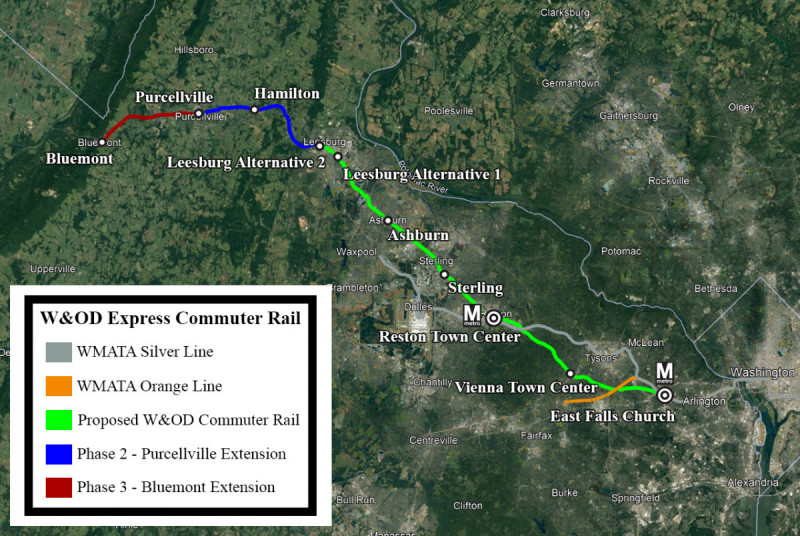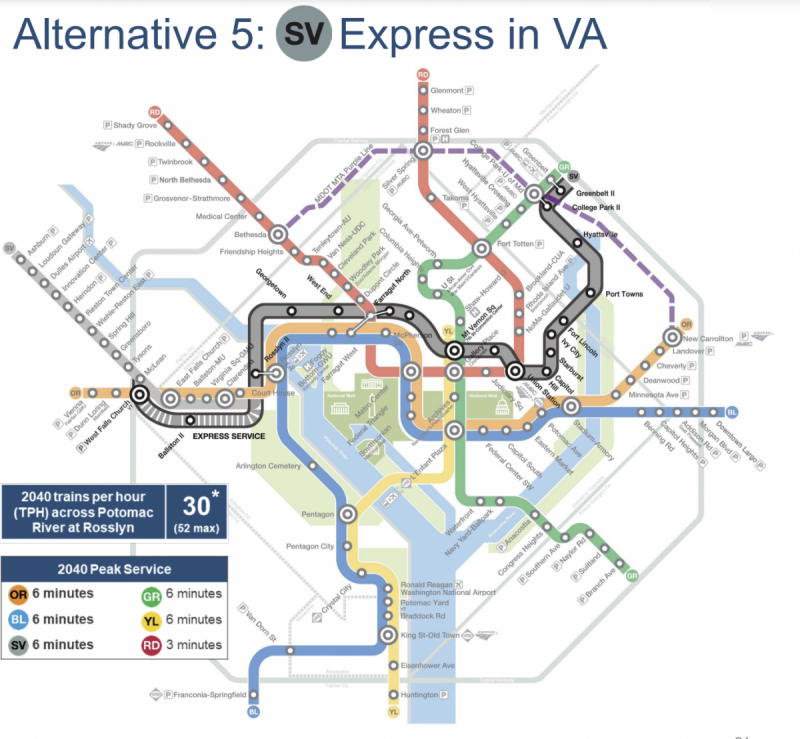Is it time to bring back the W&OD as commuter rail?

Map of the proposed W&OD Express Commuter Rail, with possible extensions and stations shown. Image by the author using Google Earth.
Northern Virginia has grown rapidly in the last 50 years, and unlike many other regions that have seen substantial growth such as Charlotte or Atlanta, it has built a strong public transportation system. This system has functioned well for those living in the eastern part of the region, and has recently expanded westward. But, there’s still room for improvement. Leesburg—Loudoun County’s most densely populated city and the county seat—has remained disconnected from the network. As WMATA and other regional transportation agencies look at ambitious expansion plans, it is time to look for affordable options that connect densely-populated areas at a low cost.
To remedy western Loudoun’s disconnection from transit, and provide a faster, “express” commuter rail option for people across the region, I propose rebuilding the Washington and Old Dominion (W&OD) as a commuter railroad connecting either Leesburg or Purcellville to the East Falls Church Metro station, where riders could continue towards the region’s core.
The history
For those who are unfamiliar, the W&OD was a railroad that once spanned from Bluemont, a town on the western edge of Loudoun County, through Leesburg to Rosslyn and Alexandria. It spurred development along its route, building much of the historic Northern Virginia we see today. Since its abandonment in 1968, the county has lacked train service for 54 years. Eastern Loudoun finally regained train service with the opening of Metro’s Silver Line Extension in 2022, marking a new era in connectivity.
The new Silver Line has created an excellent public transit connection for many, providing easy access to Dulles Airport, Reston and Tysons. However, it just isn’t enough in its current form. Its winding route with many stops makes it slower than driving (17 minutes slower between the Ashburn and Rosslyn stations).
Its location is also less than ideal: It sits in the middle of a busy highway, making development along its route difficult. Instead of trying to be commuter rail, the Silver Line should be what it should have been from the start: A Metro line and airport train.
If commuters move to a new W&OD, public pressure for faster service will all but go away, letting Metro build new stations at locations such as Wolf Trap. Metro and a new W&OD aren’t competitors: They can coexist and benefit each other as riders transfer between the different services.
Why the W&OD?
WMATA has recently proposed a “Silver Line Express,” a version of Metro’s Silver Line that skips a number of stations. At first glance, the plan seems to solve the issue of speed. While that may be true, it would still be wildly expensive. The original Silver Line cost a staggering $6 billion, and it was mostly built on a highway median. The Silver Express plan would require building either an elevated or underground train for miles, a fantastically expensive proposition.
Map of the proposed Silver Line Express service created by WMATA for the Blue Orange Silver Line Study. 
The W&OD, on the other hand, still exists as a bike trail, and is a very straight path through Northern Virginia’s notoriously expensive real estate, sitting on a surprisingly wide strip of land. By using this path to construct a train, you save on one of the largest costs with transit projects: Buying land. Haggling with every property owner along a route is an expensive and time-consuming process – just look at the California High-Speed Rail project.
The straightness of this path provides more advantages than just cost, too. It would allow trains to move fast, likely 90 miles per hour or faster. This high speed would be the push that Northern Virginia’s drivers need to decide to take the train. The total travel time between Leesburg and DC under the proposal would be just under 45 minutes, between 5-10 minutes faster than driving depending on traffic. Moving commuters from roads to rails would reduce traffic and roadway accidents, reduce carbon emissions and reduce dependency on cars, letting families spend less on car payments and insurance.
It also passes through many of the region’s historic (and densely populated) downtowns. This plan would see downtown Vienna, Leesburg and Purcellville’s historic train stations reopen. They would see a revitalization of their historic town centers, as commuters could live downtown and commute without a car, and DC residents seeking a quaint weekend retreat would shop and dine at local businesses.
People may ask, what about the trail? Will it have to be sacrificed for the project? The answer: Most likely not! The trail itself may only be a couple feet wide, but the park land is 100 feet wide. This means that the trail can most likely coexist with the new train tracks. California’s SMART commuter rail has done exactly this, building a trail alongside their tracks.
Why now?
Proposals to rebuild the W&OD have existed for quite some time, so why is now the right time to do it?
With the Silver line fully open as of 2022, WMATA has recently been studying new expansion plans, including the Silver Express mentioned above. The issue with their proposals is that all of them would be incredibly expensive, requiring tunnels which can cost over $1 billion per mile.
The plans include a metro line through Georgetown that passes mere blocks away from the current line shared by the Orange, Blue and Silver lines along I St NW. The problem is, the areas around the new line are all within walking distance of existing stations, or already have frequent bus service. This is not the case with downtown Vienna and western Loudoun. While a Metro expansion to Georgetown would certainly benefit the wealthy neighborhood, connecting more communities for less should be the goal of any expansion plan.
Rebuilding the W&OD saves on tunneling costs, while connecting six communities that currently lack public transit and are tens of miles away from current stations. One quarter of Loudoun residents work from home, and while work from home is often used as a justification to oppose transit development, the reality is that transit projects must adapt: The era of commuter rail that departs in the morning and returns in the evening is over. This proposal provides intracounty and regional transit for this growing segment of the population, allowing those working from home to ditch their cars during the day. Meanwhile, the majority still commuting long distances could go from Leesburg to Foggy Bottom in 45 minutes, a trip faster than driving and significantly cheaper—especially considering the tolls that are all but necessary for a reasonable commute.
The difference between this proposal and previous ones is that this ends at the East Falls Church Metro station. The reason for this — instead of a line that goes directly into DC — is quite simple: Cost. The same tunnels that make WMATA’s plans so expensive would also be needed to bring the W&OD further east. By allowing riders to quickly transfer to Metro, billions could be saved and the ride is still much faster than taking the Silver Line or driving.
By moving forward on this project, local transit agencies can show bold leadership, choosing an innovative project that connects densely-populated and historic communities for a low price. American public transportation projects have long suffered from high costs and lackluster results, but it doesn’t have to be that way. Choosing this project breaks from that trend, leveraging an existing corridor to provide an effective and fast transit connection quickly and for less. It would revitalize historic downtowns and spread the benefits of growing development more evenly across the region. The abandonment of the W&OD railroad marked a serious policy failure, but its reactivation offers a chance for redemption.
Click here to view the full proposal, which includes the project’s benefits, the precise route and station locations, preliminary technical specifications, and detailed travel time estimates.
